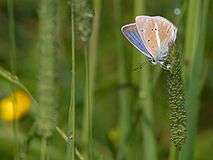Polyommatus damon
| Polyommatus damon | |
|---|---|
| Polyommatus damon. Male, upperface | |
| Polyommatus damon. Female, upperface | |
| Scientific classification | |
| Kingdom: | Animalia |
| Clade: | Euarthropoda |
| Class: | Insecta |
| Order: | Lepidoptera |
| Family: | Lycaenidae |
| Genus: | Polyommatus |
| Species: | P. damon |
| Binomial name | |
| Polyommatus damon Denis & Schiffermüller, 1775 | |
| Synonyms | |
| |
Polyommatus damon, the Damon blue, is a butterfly of the family Lycaenidae.
Subspecies
Subspecies include:[1]
- Polyommatus damon damon - (Central and Southern Europe)
- Polyommatus damon kotshubeji (Sovinsky, 1915) – (Transcaucasia)
- Polyommatus damon merzbacheri (Courvoisier, 1913) - (Dzungarian Alatau Mountains)
- Polyommatus damon mongolensis (Koçak, 1980) – (Mongolia, South Siberia, Altai mountains)
- Polyommatus damon noguerae (De Sagarra, 1924) – (Central and Northern Spain)
- Polyommatus damon ultramarina (Schawerda, 1924) - (Alps)
- Polyommatus damon zhicharevi (Sovinsky, 1915) - (North Caucasus, South East Europe)
Distribution and habitat
The Damon blue can be found in Central and Southern Europe (central Spain, Pyrenees, Alps, Balkans and the Carpathians) and in temperate parts of Asia.[1] This mountain species inhabits dry bushy or light woodlands and open grassy places at an elevation of 1,000–2,100 metres (3,300–6,900 ft) above sea level.[2][3][4]
Description
Polyommatus damon has a wingspan of 20–34 mm.[2] These small butterflies present a sexual dimorphism. The upperside of the wings is shining blue in males, with broad black borders and prominent veins. The upperside of the wings is brown in females. The underface of wings is ocher or pale grey-brown with a series of brown-black spots surrounded by white. Hindwings shows a white streak in both sexes. Both sexes have also a white fringe.[2][3][5]
Biology
The butterfly flies from June to August. The larvae feed on Onobrychis species and Medicago falcata.[1] Larvae are attended by ants (Lasius niger, Lasius alienus, Formica pratensis).[6][7]
Gallery
- Mating pair
- Female, underface
 Male, underface
Male, underface_damon-000.jpg) Feeding on nectar
Feeding on nectar
External links
| Wikimedia Commons has media related to Polyommatus damon. |
References
- 1 2 3 Funet
- 1 2 3 Simon Coombe Captain's European Butterfly Guide
- 1 2 Matt Rowlings Euro Butterflies
- ↑ Fauna europaea
- ↑ Butterflies and Moths DK Pocket Nature
- ↑ Paolo Mazzei, Daniel Morel, Raniero Panfili Moths and Butterflies of Europe and North Africa
- ↑ Guide des papillons d'Europe et d'Afrique du Nord, Delachaux et Niestlé,Tom Tolman, Richard Lewington, ( ISBN 978-2-603-01649-7)